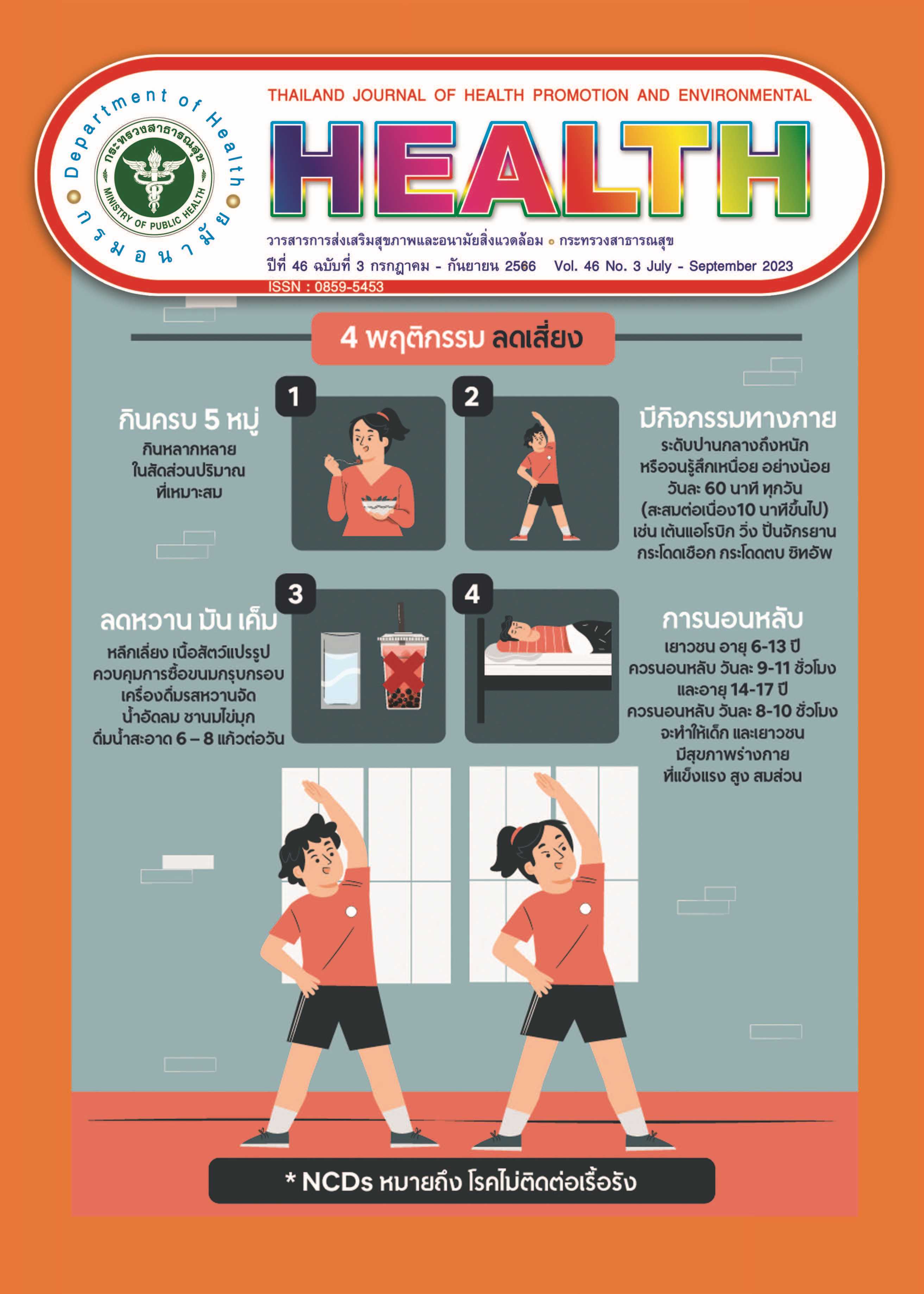การพัฒนารูปแบบการจัดการมูลฝอยติดเชื้อในชุมชน จังหวัดภูเก็ต
คำสำคัญ:
การจัดการมูลฝอยติดเชื้อ, มูลฝอยติดเชื้อในชุมชน, การมีส่วนร่วมของชุมชน, การคัดแยกมูลฝอยบทคัดย่อ
การวิจัยนี้เป็นวิจัยเชิงปฏิบัติการมีวัตถุประสงค์เพื่อพัฒนารูปแบบการจัดการมูลฝอยติดเชื้อในชุมชน การเตรียมความพร้อมในการพัฒนารูปแบบการจัดการมูลฝอยติดเชื้อในชุมชน จังหวัดภูเก็ต และประเมินประสิทธิผลการดำเนินการโดยใช้แบบสังเกตการณ์การจัดการมูลฝอยติดเชื้อใน 12 ชุมชน ในพื้นที่องค์กรปกครองส่วนท้องถิ่นจำนวน 4 แห่ง ที่มีขนาดแตกต่างกัน พร้อมประเมินผลระดับความรู้และพฤติกรรมการปฏิบัติของประชาชนในการจัดการมูลฝอยติดเชื้อ 211 คน โดยใช้แบบสอบถามมีค่าสัมประสิทธิ์แอลฟาครอนบาคเท่ากับ 0.89 เก็บรวบรวมข้อมูลในปี 2565 ถึง 2566 วิเคราะห์ข้อมูลเชิงคุณภาพตามวัตถุประสงค์การศึกษา และใช้สถิติเปรียบเทียบ Paired samples t-test ผลการศึกษาพบว่า รูปแบบการจัดการมูลฝอยติดเชื้อในชุมชนที่เหมาะสมและปลอดภัยต้องมีการบริหารจัดการมูลฝอยติดเชื้อแบบมีส่วนร่วมของชุมชนที่กำหนดบทบาทหน้าที่ของผู้เกี่ยวข้องอย่างชัดเจน และมีแนวทางขั้นตอนการปฏิบัติที่ถูกต้องตั้งแต่การคัดแยก เก็บรวบรวม เก็บขนและกำจัด โดยใช้กลยุทธการขับเคลื่อนผ่านกลไกคณะกรรมการระดับจังหวัด การสร้างความเข้มแข็งภาคีเครือข่ายการจัดการมูลฝอยติดเชื้อในชุมชน และการสื่อสารสร้างความรอบรู้ในการจัดการมูลฝอยติดเชื้อที่ถูกต้องของประชาชน ผลการประเมินประสิทธิผลพบว่า ชุมชน และหน่วยงานที่เกี่ยวข้องส่วนใหญ่สามารถดำเนินการตามรูปแบบที่กำหนดได้ มีเพียงประเด็นการสนับสนุน วัสดุอุปกรณ์ให้แก่ชุมชนและการจัดให้มีจุดทิ้งมูลฝอยติดเชื้อในชุมชนที่เพียงพอและครอบคลุมที่พบมีปัญหาในบางพื้นที่ ประชาชนบางส่วนไม่ได้ทำสัญลักษณ์เพื่อเป็นการแสดงให้บุคคลอื่นทราบว่าเป็นมูลฝอยติดเชื้อและพบมีการทิ้งมูลฝอยติดเชื้อรวมไปกับมูลฝอยทั่วไปอยู่บ้าง สำหรับระดับความรู้และพฤติกรรมการปฏิบัติของประชาชนพบว่า หลังการดำเนินการประชาชนมีความรูแ้ ละพฤติกรรมการปฏิบัติอยูใ่ นระดับสูงกวา่ กอ่ นดำเนินการอย่างมีนัยสำคัญทางสถิติ (p<0.05) ดังนั้น ชุมชนและหน่วยงานที่เกี่ยวข้องควรร่วมกันดำเนินการตามรูปแบบที่กำหนดอย่างต่อเนื่อง ร่วมกันวิเคราะห์และวางแผนแก้ไขปัญหาในส่วนที่ยังไม่สามารถดำเนินการได้ ทั้งนี้ เพื่อให้มูลฝอยติดเชื้อทั้งหมดได้รับการจัดการอย่างถูกต้อง
ดาวน์โหลด
เผยแพร่แล้ว
ฉบับ
บท
การอนุญาต
ลิขสิทธิ์ (c) 2023 วารสารการส่งเสริมสุขภาพและอนามัยสิ่งแวดล้อม

This work is licensed under a Creative Commons Attribution-NonCommercial-NoDerivatives 4.0 International License.

